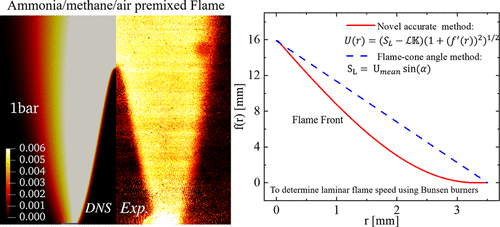当前位置:
X-MOL 学术
›
Energy Fuels
›
论文详情
Our official English website, www.x-mol.net, welcomes your
feedback! (Note: you will need to create a separate account there.)
Structure and Laminar Flame Speed of an Ammonia/Methane/Air Premixed Flame under Varying Pressure and Equivalence Ratio
Energy & Fuels ( IF 5.2 ) Pub Date : 2021-01-22 , DOI: 10.1021/acs.energyfuels.0c03520 Rodolfo C. Rocha 1, 2 , Shenghui Zhong 1, 3 , Leilei Xu 1 , Xue-Song Bai 1 , Mário Costa 2 , Xiao Cai 4 , Haisol Kim 4 , Christian Brackmann 4 , Zhongshan Li 4 , Marcus Aldén 4
Energy & Fuels ( IF 5.2 ) Pub Date : 2021-01-22 , DOI: 10.1021/acs.energyfuels.0c03520 Rodolfo C. Rocha 1, 2 , Shenghui Zhong 1, 3 , Leilei Xu 1 , Xue-Song Bai 1 , Mário Costa 2 , Xiao Cai 4 , Haisol Kim 4 , Christian Brackmann 4 , Zhongshan Li 4 , Marcus Aldén 4
Affiliation

|
This paper presents a joint experimental and numerical study on premixed laminar ammonia/methane/air flames, aiming to characterize the flame structures and NO formation and determine the laminar flame speed under different pressure, equivalence ratio, and ammonia fraction in the fuel. The experiments were carried out in a lab-scale pressurized vessel with a Bunsen burner installed with a concentric co-flow of air. Measurements of NH and NO distributions in the flames were made using planar laser-induced fluorescence. A novel method was presented for determination of the laminar flame speed from Bunsen-burner flame measurements, which takes into account the non-uniform flow in the unburned mixture and local flame stretch. NH profiles were chosen as flame front markers. Direct numerical simulation of the flames and one-dimensional chemical kinetic modeling were performed to enhance the understanding of flame structures and evaluate three chemical kinetic mechanisms recently reported in the literature. The stoichiometric and fuel-rich flames exhibit a dual-flame structure, with an inner premixed flame and an outer diffusion flame. The two flames interact, which affects the NO emissions. The impact of the diffusion flame on the laminar flame speed of the inner premixed flame is however minor. At elevated pressures or higher ammonia/methane ratios, the emission of NO is suppressed as a result of the reduced radical mass fraction and promoted NO reduction reactions. It is found that the laminar flame speed measured in the present experiments can be captured by the investigated mechanisms, but quantitative predictions of the NO distribution require further model development.
中文翻译:

变压和当量比下氨/甲烷/空气预混火焰的结构和层流火焰速度
本文对预混合层流氨/甲烷/空气火焰进行了联合实验和数值研究,旨在表征火焰结构和NO的形成,并确定在不同压力,当量比和燃料中氨含量下的层流速度。实验是在实验室规模的加压容器中进行的,该容器中装有本森燃烧器,并装有同心的空气同流。使用平面激光诱导的荧光测量火焰中NH和NO的分布。提出了一种通过本生燃烧器火焰测量确定层流火焰速度的新方法,该方法考虑了未燃烧混合物中的不均匀流动和局部火焰拉伸。选择NH轮廓作为火焰前锋标记。进行了火焰的直接数值模拟和一维化学动力学建模,以增强对火焰结构的理解并评估文献中最近报道的三种化学动力学机理。化学计量的和富燃料的火焰表现出双重火焰结构,具有内部预混合火焰和外部扩散火焰。两个火焰相互作用,影响NO排放。但是,扩散火焰对内部预混火焰的层流火焰速度的影响很小。在升高的压力或更高的氨/甲烷比下,由于自由基质量分数降低和NO还原反应加快,NO的排放受到抑制。发现在本实验中测得的层流火焰速度可以通过研究的机理来捕获,
更新日期:2021-01-22
中文翻译:

变压和当量比下氨/甲烷/空气预混火焰的结构和层流火焰速度
本文对预混合层流氨/甲烷/空气火焰进行了联合实验和数值研究,旨在表征火焰结构和NO的形成,并确定在不同压力,当量比和燃料中氨含量下的层流速度。实验是在实验室规模的加压容器中进行的,该容器中装有本森燃烧器,并装有同心的空气同流。使用平面激光诱导的荧光测量火焰中NH和NO的分布。提出了一种通过本生燃烧器火焰测量确定层流火焰速度的新方法,该方法考虑了未燃烧混合物中的不均匀流动和局部火焰拉伸。选择NH轮廓作为火焰前锋标记。进行了火焰的直接数值模拟和一维化学动力学建模,以增强对火焰结构的理解并评估文献中最近报道的三种化学动力学机理。化学计量的和富燃料的火焰表现出双重火焰结构,具有内部预混合火焰和外部扩散火焰。两个火焰相互作用,影响NO排放。但是,扩散火焰对内部预混火焰的层流火焰速度的影响很小。在升高的压力或更高的氨/甲烷比下,由于自由基质量分数降低和NO还原反应加快,NO的排放受到抑制。发现在本实验中测得的层流火焰速度可以通过研究的机理来捕获,











































 京公网安备 11010802027423号
京公网安备 11010802027423号